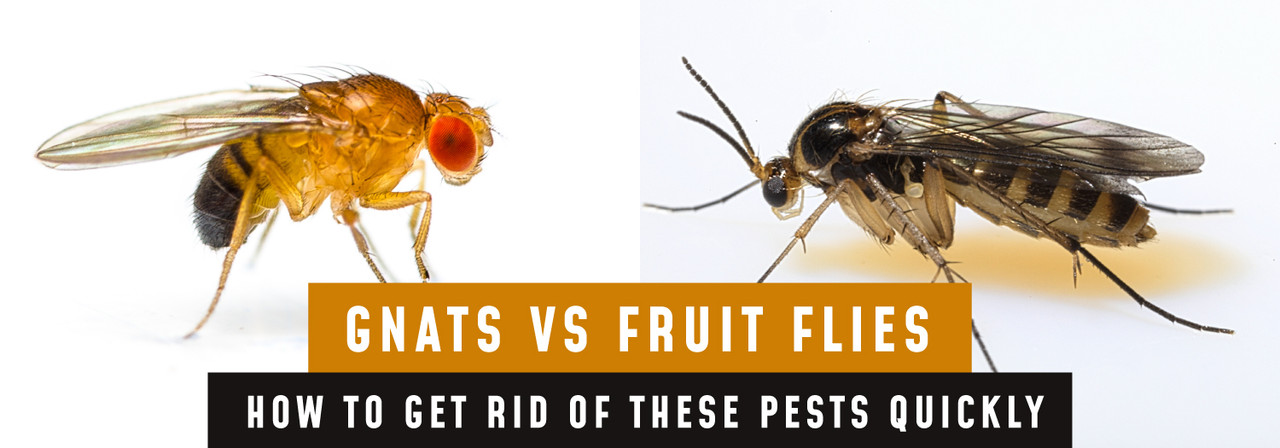When dealing with pesky flying insects in your home or garden, identifying whether you’re facing fruit flies or gnats is crucial for effective management. While both are small and can be equally annoying, they have distinct characteristics and behaviors that can help you differentiate between them. This article provides a detailed comparison of fruit flies and gnats, highlighting their physical differences, behavior, and preferred environments to help you accurately identify and address the infestation.
Understanding Fruit Flies and Gnats
Fruit Flies
Appearance:
- Size: Fruit flies are typically about 1/8 inch long, making them one of the smallest flying insects.
- Color: They usually have a light brown or tan body with reddish eyes. Some species may appear more yellowish.
- Wings: Their wings are clear with a slightly brownish tint and have a characteristic pattern of dark bands.
- Body: Fruit flies have a rounded, somewhat bulbous abdomen and a relatively short, stout body.
Behavior and Habits:
- Attraction: Fruit flies are highly attracted to overripe, rotting, or fermenting fruits and vegetables. They are also drawn to sugary substances and can be found around spilled drinks or in garbage bins with food waste.
- Life Cycle: Their life cycle is rapid, with eggs hatching into larvae within a day or two. The larvae feed on decaying matter before maturing into adults within about a week.
- Flight Pattern: Fruit flies are known for their erratic flight patterns, often darting in short bursts and appearing to hover around their food sources.
Preferred Environments:
- Indoors: Inside the home, fruit flies are commonly found in kitchens, particularly around fruit bowls, garbage disposals, and compost bins.
- Outdoors: They can also be found in outdoor areas where fruit and vegetables are left out or where compost is maintained.
Gnats
Appearance:
- Size: Gnats are slightly larger than fruit flies, generally ranging from 1/8 inch to 1/4 inch in length.
- Color: They vary in color depending on the species, but many gnats have a darker, more slender body compared to fruit flies. They can appear black, gray, or even greenish.
- Wings: Gnat wings are often more elongated and transparent, without the distinctive dark bands found in fruit flies. They typically have a more delicate and elongated appearance.
- Body: Gnats have a more slender, elongated body with long, thin legs and antennae that are more noticeable than those of fruit flies.
Behavior and Habits:
- Life Cycle: Gnats generally lay their eggs in moist soil or organic matter. The larvae thrive in damp environments and feed on fungi and decaying matter before pupating and emerging as adults.
- Flight Pattern: Gnats often fly in clusters or clouds and can be more persistent in their hovering behavior.
Preferred Environments:
- Indoors: Inside, gnats are often found around potted plants, overwatered soil, or areas with high humidity, such as bathrooms or basements.
- Outdoors: They are prevalent in gardens, compost heaps, and any place where organic matter is breaking down or where there is excessive moisture.
Key Differences Between Fruit Flies and Gnats
- Size and Body Shape
- Fruit Flies: Smaller, more rounded body with short legs and a bulbous abdomen.
- Gnats: Slightly larger with a slender, elongated body and long legs.
- Color and Wing Structure
- Fruit Flies: Light brown or tan with reddish eyes and wings with dark bands.
- Gnats: Vary in color but generally darker with long, transparent wings.
- Flight Behavior
- Fruit Flies: Erratic flight patterns with short bursts and hovering.
- Gnats: More likely to fly in clouds or clusters and exhibit a more persistent hovering.
- Attraction and Habitats
- Fruit Flies: Attracted to fruits, vegetables, and sugary substances; found in kitchens and areas with rotting food.
- Gnats: Attracted to moisture and decaying organic matter; commonly found around houseplants and in moist areas.
Managing and Preventing Infestations
For Fruit Flies:
- Eliminate Attractants: Dispose of overripe fruit, clean spills, and keep garbage bins tightly sealed.
- Clean Up: Regularly clean drains and countertops where fruit flies may breed.
- Use Traps: Fruit fly traps, which often use vinegar or a sugary solution to attract and capture them, can help control their numbers.
For Gnats:
- Reduce Moisture: Avoid overwatering plants and ensure proper drainage. Remove any decaying organic matter from the soil.
- Improve Air Circulation: Ensure good air circulation around houseplants to reduce humidity.
- However, always follow safety instructions when using chemicals.
Conclusion
Distinguishing between fruit flies and gnats is essential for effective pest control and management. By recognizing their physical differences, behaviors, and preferred environments, you can more accurately identify the type of pest you’re dealing with. Implementing targeted control measures based on their specific habits will help you manage and prevent infestations, ensuring a more comfortable and pest-free living space.

Leave a Reply